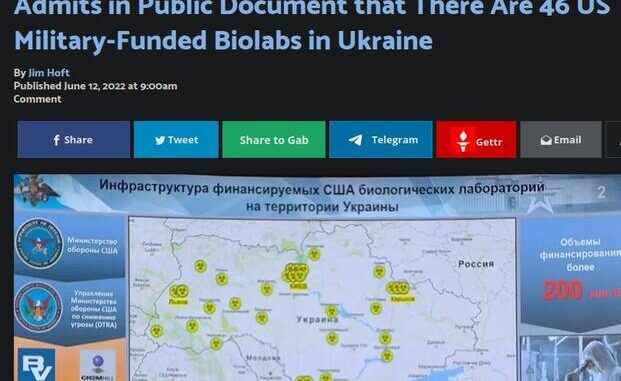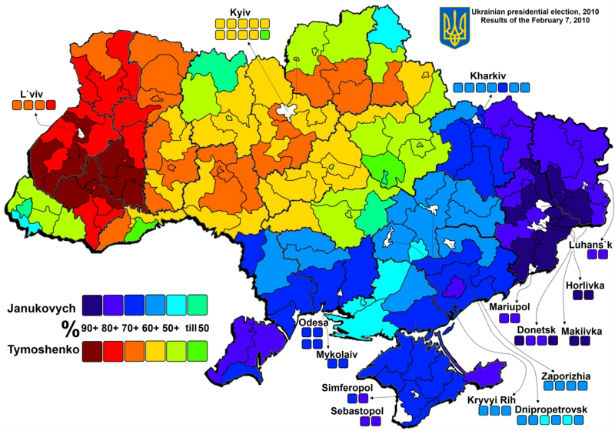
Det skriver Alexander G. Markovsky her
Taget herfra
It is widely accepted that the Ukrainian crisis erupted into a military conflict on February 24, 2022, with the Russian invasion of Ukraine. Contrary to conventional wisdom, the seeds of the hostilities were planted about thirty years earlier by President Clinton and, later, by George W. Bush, both of whom recklessly pushed for NATO’s eastward expansion.
Over the years, Gorbachev, Yeltsin, and Putin repeatedly warned that Moscow would not tolerate continuing NATO’s “Drang nach Osten” (“drive to the East”), particularly Ukraine’s membership and the subsequent establishment of NATO military bases along the Russian border.
On February 25, 2024, The New York Times published an article confirming Moscow’s fears. The article revealed that US intelligence not only played a crucial role in Ukraine’s wartime decision-making but also established and funded advanced command-and-control spy centers long before the Russian invasion on Feb. 24, 2022.
The newspaper exposed how, over the last decade, the CIA has operated a network of twelve bases in Ukraine. These bases, which enable the interception of Russian military communications and monitoring of spy satellites, are utilized to launch and monitor drone and missile attacks on Russian soil. With American biological weapon facilities scattered across Ukraine, it is understandable that Moscow perceived this as a significant threat to Russia’s national security.

Would the United States accept the presence of Russian military bases on its borders? As a matter of fact, it did not accept them even 1,500 miles from its borders. In 1983, President Reagan ordered the invasion of Grenada due to concerns that the construction of an airport by Cubans could potentially be utilized by Soviet forces.
It is essential to note that Putin’s case was much more compelling than Reagan’s. Unlike Ukraine, Grenada did not share a border with the United States, and there was no Russian military presence in Grenada, making Reagan’s concerns mostly hypothetical. It is worth mentioning that, despite dubious justification for the American invasion, the United States was not labeled as an aggressor, nor was Ronald Reagan referred to as a war criminal.
In fact, Putin tried to avoid the current conflict. On September 7, 2023, as NATO Secretary General Jens Stoltenberg told a European Parliament joint committee meeting:
President Putin declared in the autumn of 2021, and actually sent a draft treaty that they wanted NATO to sign, to promise no more NATO enlargement. That was what he sent us. And [that] was a pre-condition for not invade [sic] Ukraine. Of course we didn’t sign that.
Russia’s geographical vulnerability has been a concern for Russian leaders since the time of Peter the Great. Stoltenberg should have been mindful of Russia’s sensitivities if he wanted to avoid a conflict.
Stoltenberg did not elaborate on why he did not accept the treaty draft, why negotiations were not pursued, or why all the alternatives to conflict had not been explored. Ultimately, his unwillingness to engage in talks put the matter beyond the power of diplomacy.
Diplomacy was not given a chance because NATO needed to restore its image and validate its continued existence following a 30-year history of failure. The pursuit of “nation-building”—replacing authoritarian stability with democracy in countries that do not conform to the Bill of Rights—has accomplished neither. Instead, it has resulted in the loss of millions of lives and the devastation of many countries.
Furthermore, after a disastrous 2021 retreat from Afghanistan, the alliance lost the adversary that had long defined its purpose. Since a military alliance cannot exist without a rival, NATO’s need for a credible enemy was an existential necessity. The Russian incursion into Ukraine could create the perception of a common threat and portray NATO as an indispensable pillar of global security, especially if NATO emerged victorious.
This being the case, the Europeans lacked the capability to seek revenge independently for centuries of military defeats and humiliations at the hands of the Russian Empire. After the empire’s fall, the Soviet Union discerned an opportunity for retaliation without direct military involvement.
Moreover, for President Biden, who was desperate to escape the Afghanistan disaster, a victorious conflict would be a pivotal moment in his presidency. Additionally, he never made a secret that he aspired to bring about a change in leadership in Moscow.
And, of course, there was Ukraine. Never in the realm of international relations was there a state that acted so consistently against its national interests. It put itself in grave danger when it announced its intention to join NATO in 2004, violating the 1997 Treaty on Friendship between Ukraine and the Russian Federation. This Treaty specifically addressed Ukrainian neutrality, stating at section 6, page 148:
Each High Contracting Party shall refrain from participating in, or supporting, any actions directed against the other High Contracting Party, and shall not conclude any treaties with third countries against the other Party. Neither Party shall allow its territory to be used to the detriment of the security of the other Party.
Ukraine’s leaders never grasped that Moscow saw this treaty as a key element of Russia’s security and would not allow Ukraine to violate its terms with impunity. Zelensky could have avoided the war by renouncing his NATO membership request and meeting Moscow’s demands, thus saving the country from destruction. However, the corrupt leaders in Kiev were driven by financial and military aid and were seeking conflict for personal gain.
Truth in politics involves various viewpoints and analyses, which are often influenced by one’s ideological background. However, facts matter.
The preceding facts illustrate a common overriding interest among NATO leadership, its member states, and Ukraine in instigating the invasion, albeit for varying reasons. Russia was the sole party that attempted to prevent the conflict.
Alexander G. Markovsky is a senior fellow at the London Center for Policy Research, a conservative think tank that examines national security, energy, risk analysis, and other public policy issues. He is the author of “Anatomy of a Bolshevik” and “Liberal Bolshevism: America Did Not Defeat Communism, She Adopted It.” Mr. Markovsky is the owner and CEO of Litwin Management Services, LLC. He can be reached at alex.g.markovsky@gmail.com
Taget herfra
Det er desværre nok for sent nu, men den “rigtige” løsning – dvs den, der inden krigen havde haft størst chance for at undgå krig – var en folkeafstemning under internatiaonal kontrol i Ukraine , hvor befolkningen kunne bestemme , hvilke dele af Ukraine, som ville være vestligt orienteret(dvs EU/eruropa) og hvilke, som ville være østligt orienteret(dvs Rusland)

Som du kan se af denne fordeling af valget i 2010, ville en folkeafstemning stort set have sikre at ukrainere kom under den suverenitet, de selv ønskede.
Kun Vaslav Havel fra Tjekkoslovakiet var fornuftig nok til at vælge en sådan løsning, som delte Tjekkoslovakiet i to selvstændige stater Tjekkiet og Slovakiet, der i dag lever i fred med hinanden
Nu er den fredelige løsning desværre nok en umulighed i Ukraine 🙁
Der er nogle problemer i den artikel.
Problemet er at Russerne ikke ønskede et valg om deling af øst og vest fordi valget som Zelenskyj vandt skete ved at han fik mange stemmer i øst. Zelenskyj gjorde det umulige og var ved at forene Ukraine. Det var det der gjorde udslaget for det vil Russerne ikke acceptere. (Bemærk at artikel bruger valget fra 2010)
Og så er der lige det at Putin har selv udtalt at han var ligeglad med Nato og på et tidspunkt blev det diskuteret om Rusland skulle med i Nato.
Russernes reaktion på et selvstændigt suverænt Ukraine har rystet russerne så meget at de er faldet tilbage til et ønske om Soviet statens genkomst hvor grænserne nåede bjergkæder etc der danner en naturlig sikkerhedsbarriere og det betyder at de nu vil have Moldova, Estland, Letland, Litauen og halvdelen af Polen og selvfølgelig Ukraine.
Jep – Tyskland til Kongeåen. Det kan nås endnu, eller er de der allerede?
KL, det er noget sluder det du skriver.